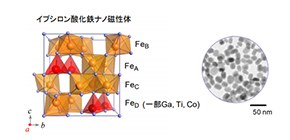
Novel magnet tape recording systems using epsilon-iron oxide magnetic nanoparticles
Researchers observe light-assisted magnetization reversal and ultrafast response of magnetization reversal by terahertz pulsed laser irradiation
A joint group of researchers from The University of Tokyo and Osaka University observed two phenomena in chemically synthesized magnetic films based on gallium–titanium–cobalt-substituted epsilon-iron oxide (GTC-ε-Fe 2 O 3 ) and ε-Fe 2 O 3 nanoparticles: (1) the magnetization reversal induced by nanosecond visible-light laser and (2) the ultrafast dynamic magnetooptical effect caused by terahertz (THz) pulsed laser irradiation.
To develop high density recording systems for the Big Data Era, studying functional nanomaterials is essential. Magnetic materials can be used for magnetic recording systems and magnetic nanoparticles with a high magnetic coercive force are particularly important for magnetism recording media such as magnetic tapes. ε-Fe 2 O 3 , which has a large magnetic coercive force and whose particle size can be reduced 8 nm or less, receives attention as a next-generation magnetic material for magnetic data recording.
The recording density of magnetic writing technology has reached its physical limit. It is anticipated that light- or electromagnetic wave-assisted magnetic recording will become a next-generation writing method for increasing the recording density of magnetic recording media. If light- or electromagnetic wave-mediated magnetic recording is achieved in ε-Fe 2 O 3 , it will lead to the development of next-generation high density magnetic recording.
This group irradiated chemically synthesized magnetic films based on gallium–titanium–cobalt-substituted ε- Fe 2 O 3 (GTC-ε- Fe 2 O 3 ) films with visible-light pulsed laser under the application of a weak external magnetic field. The visible-light pulsed laser switched the sign of the Faraday effect; that is, a light-assisted magnetization reversal was generated on ε-iron oxide.
They also fabricated magnetic films based on ε- Fe 2 O 3 nanoparticles, irradiating the ε- Fe 2 O 3 magnetic films with intense pulsed THz light. The THz light irradiation under a zero magnetic field instantly decreased the magnetization, which returned to its original state after the THz light passed. The response on the Faraday rotation occurred in an extremely short time of 400 fs. This means that the rapid response to THz pulsed light enables writing/erasing within less than 1 ps. The time evolution dynamics of these ultrafast magneto-optical effects are also theoretically demonstrated.
In this study, the researchers clarified that recording on nanoparticles with a large coercive field could be achieved by assisting the magnetization reversal by light irradiation, demonstrating the possibilities of next-generation high density magnetic tape recording methods. The rapid response to THz pulsed light enables writing/erasing within less than 1 ps, permitting high-speed calculation due to THz repetition frequency. ε-Fe 2 O 3 magnetic nanomaterials will contribute to the development of high density magnetic recording media and spintronics devices with high-speed operation circuits.
Abstract
Light- or electromagnetic wave-responsive magnetism is an attractive issue in spin chemistry and optical materials science. Herein we show the magnetization reversal induced by visible-light pulsed laser and the ultrafast dynamic magnetooptical effect caused by terahertz (THz) pulsed laser irradiation onto chemically synthesized magnetic films based on gallium–titanium–cobalt-substituted ε-Fe 2 O 3 (GTC-ε-Fe 2 O 3 ) and ε-Fe 2 O 3 nanoparticles. Visible-light pulsed laser irradiation switches the sign of the Faraday effect in GTC-ε-Fe 2 O 3 films. On the other hand, irradiating the ε-Fe 2 O 3 film with pulsed THz light induces an ultrafast Faraday rotation in an extremely short time of 400 fs. The time evolution dynamics of these ultrafast magnetooptical effects are theoretically demonstrated by stochastic Landau–Lifshitz–Gilbert calculations of a nanoparticle model that considers all motions of the individual spins. These ε-iron oxide magnetic nanomaterials are expected to contribute to high-density magnetic memory media or high-speed operation circuit magnetic devices.

Figure 1

Figure 2

Figure 3

Figure 4
The article, “Rapid Faraday Rotation on Epsilon-Iron Oxide Magnetic Nanoparticlesby Visible- and THz-Pulsed Lights” was published in the Journal of the American Chemical Society at DOI: https://doi.org/ 10.1021/jacs.8b12910 .
Related links
- Institute of Laser Engineering, Osaka Universeity (link in Japanese)

